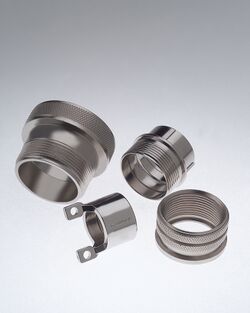Engineering:Electroless plating
Electroless plating, also known as chemical plating or autocatalytic plating, is a class of industrial chemical processes that create metal coatings on various materials by autocatalytic chemical reduction of metal cations in a liquid bath. This class is contrasted with electroplating processes, where the reduction is achieved by an externally generated electric current.[1][2]
The main technical advantage of electroless plating is that it creates an even layer of metal regardless of the geometry of the surface—in contrast to electroplating, which suffers from uneven current density due to the effect of substrate shape on the electrical resistance of the bath. Moreover, electroless plating can be applied to non-conductive surfaces and parts of the object that cannot be connected to the current source.[1][2]
Electroless plating has many industrial applications, from merely decorative to the prevention of corrosion and wear. It can even be used to coat individual grains of powdered materials, with arbitrarily small size.[3] It can also be used to create composite coatings, by suspending suitable powders in the bath.[4]
History
The earliest electroless plating process can be considered to be Tollen's reaction, that deposited a uniform metallic silver layer on glass and other substrates. It was extensively used for silvering mirrors.[5]
The first electroless plating process to compete with electroplating was nickel-phosphorus, using nickel salts and hypophosphite as both a reducing agent and a source of phosphorus. The reaction had been discovered in 1844 by Charles Adolphe Wurtz,[6] and had been patented in 1914 as a metal-plating method by François Auguste Roux of L'Aluminium Français.[7] However, Roux's invention did not seem to receive much commercial use. In 1946 the process was accidentally re-discovered by Abner Brenner and Grace E. Riddell of the National Bureau of Standards. [2][8] They presented their discovery at the 1946 Convention of the American Electroplaters' Society (AES);[9] a year later, at the same conference they proposed the term "electroless" for the process and described optimized bath formulations,[10] that resulted in a patent.[11][12][13]
General process
The general reaction of electroless plating is
- Mz+
(aq) + Xz-
(aq) → M0
(s) + Z
where M represents the metal, Xz-
the reducing agent, and Z its oxidized byproducts (which may be liquids, solids, or gases).
In order for the metal to be deposited as a uniform solid coating on the intended surface, rather than a precipitate through the solution, the reaction must require a catalyst that is either the substrate itself or is applied to it beforehand. In fact, the reaction must be autocatalytic, so that it can continue after the substrate has been coated by the metal. [1]
Electroless nickel plating uses nickel salts as the metal cation source and either hypophosphite (or a borohydride-like compound) as the reducer. A byproduct of the reaction is elemental phosphorus (or boron) which is incorporated in the coating. Tollens' reagent is a classical example of electroless silver plating. For other metals like gold and copper, the reducing agent is typically a low-molecular-weight aldehydes.
Main processes
- nickel-phosphorus
- nickel-gold (ENIG, ENEPIG)
- nickel-boron (NiB)
- palladium
- copper
References
- ↑ 1.0 1.1 1.2 G. O. Mallory and J. B. Hajdu, editors (1990): Electroless plating: fundamentals and applications. 539 pages. ISBN 9780936569079
- ↑ 2.0 2.1 2.2 Charles R. Shipley Jr. (1984): "Historical highlights of electroless plating". Plating and Surface Finishing, volume 71, issue 6, pages 24-27. ISSN 0360-3164
- ↑ W. T. Ferrar, D. F. O'Brien, A. Warshawsky, and C. L. Voycheck (1988): "Metalization of lipid vesicles via electroless plating". Journal of the American Chemical Association, volume 110, issue 1, pages 288–289. doi:10.1021/ja00209a046
- ↑ Sudagar, Jothi; Lian, Jianshe; Sha, Wei (2013). "Electroless nickel, alloy, composite and nano coatings - A critical review". Journal of Alloys and Compounds 571: 183–204. doi:10.1016/j.jallcom.2013.03.107. https://pure.qub.ac.uk/ws/files/126683921/Edited_sudagar_R1.pdf.
- ↑ Bernhard Tollens (1882): "[url=https://babel.hathitrust.org/cgi/pt?id=uiug.30112025692838;view=1up;seq=535 Ueber ammon-alkalische Silberlösung als Reagens auf Aldehyd]" ("On an ammonical alkaline silver solution as a reagent for aldehydes"). Berichte der Deutschen Chemischen Gesellschaft, volume 15, issue 2, pages 1635–1639. doi:10.1002/cber.18820150243
- ↑ Gavrilov, Georgi G. [translation by John E. Goodman] (1979) (in en). Chemical (electroless) nickel-plating. Redhill, England: Portcullis Press. ISBN 9780861080236. https://nla.gov.au/nla.cat-vn1160410. Retrieved 8 September 2018.
- ↑ François Auguste Roux (1914): "Process of producing metallic deposits". US Patent 1207218. Granted 1916-12-05, assigned to L'Aluminium Français, expired on 1933-12-05.
- ↑ Abner Brenner and Grace E. Riddel (1946): "Nickel plating on steel by chemical reduction". Journal of Research of the National Bureau of Standards, volume 37, pages 31–34 doi:10.6028/jres.037.019
- ↑ Abner Brenner and Grace E. Riddel (1946): Proc. 33rd Annual Convention of the American Electroplaters' Society page 23.
- ↑ Abner Brenner and Grace E. Riddel(1947): Proc. 34th Annual Convention of the American Electroplaters' Society, page 156.
- ↑ Abner Brenner and Grace E. Riddel (1950): "Nickel plating by chemical reduction". US Patent 2532283. Granted on 1950-12-05, expired on 1967-12-05.
- ↑ Abner Brenner (1954): Metal Finishing, volume 52, issue 11, page 68.
- ↑ Abner Brenner (1954): Metal Finishing, volume 52, issue 12, page 61.


